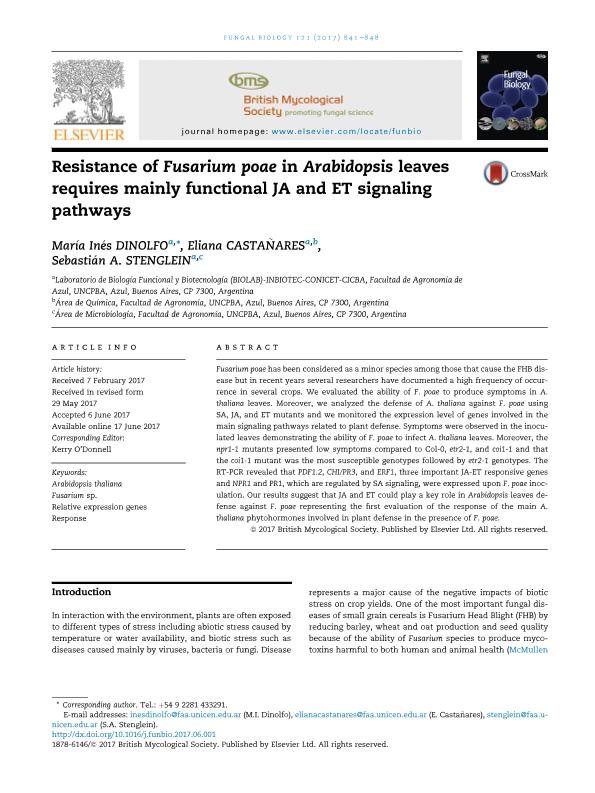Artículo
Resistance of Fusarium poae in Arabidopsis leaves requires mainly functional JA and ET signaling pathways
Fecha de publicación:
10/2017
Editorial:
Elsevier
Revista:
Fungal Biology
ISSN:
1878-6146
Idioma:
Inglés
Tipo de recurso:
Artículo publicado
Clasificación temática:
Resumen
Fusarium poae has been considered as a minor species among those that cause the FHB disease but in recent years several researchers have documented a high frequency of occurrence in several crops. We evaluated the ability of F. poae to produce symptoms in A. thaliana leaves. Moreover, we analyzed the defense of A. thaliana against F. poae using SA, JA, and ET mutants and we monitored the expression level of genes involved in the main signaling pathways related to plant defense. Symptoms were observed in the inoculated leaves demonstrating the ability of F. poae to infect A. thaliana leaves. Moreover, the npr1-1 mutants presented low symptoms compared to Col-0, etr2-1, and coi1-1 and that the coi1-1 mutant was the most susceptible genotypes followed by etr2-1 genotypes. The RT-PCR revealed that PDF1.2, CHI/PR3, and ERF1, three important JA-ET responsive genes and NPR1 and PR1, which are regulated by SA signaling, were expressed upon F. poae inoculation. Our results suggest that JA and ET could play a key role in Arabidopsis leaves defense against F. poae representing the first evaluation of the response of the main A. thaliana phytohormones involved in plant defense in the presence of F. poae.
Palabras clave:
Arabidopsis Thaliana
,
Fusarium Sp.
,
Relative Expression Genes
,
Response
Archivos asociados
Licencia
Identificadores
Colecciones
Articulos(CCT - MAR DEL PLATA)
Articulos de CTRO.CIENTIFICO TECNOL.CONICET - MAR DEL PLATA
Articulos de CTRO.CIENTIFICO TECNOL.CONICET - MAR DEL PLATA
Articulos(INBIOTEC)
Articulos de INSTITUTO DE INV. EN BIODIVERSIDAD Y BIOTECNOLOGIA
Articulos de INSTITUTO DE INV. EN BIODIVERSIDAD Y BIOTECNOLOGIA
Citación
Dinolfo, María Inés; Castañares, Eliana; Stenglein, Sebastian Alberto; Resistance of Fusarium poae in Arabidopsis leaves requires mainly functional JA and ET signaling pathways; Elsevier; Fungal Biology; 121; 10; 10-2017; 841-848
Compartir
Altmétricas




